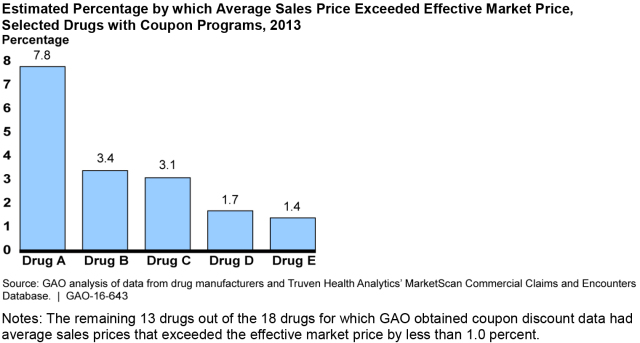The high costs of new drugs, as well as the dramatic price increases of some older and traditionally less expensive generic drugs, have thrust drug prices into the headlines.
But what’s the full story? Today, we’re shedding some light on the
cost of new drugs coming to market,
generic drug prices, and why
drug coupons complicate the picture.
Cost of new drugs
New drugs can cost a lot—both to Medicare and to the people who need these drugs. We found that Medicare and its beneficiaries spent about $5.9 billion for 75 new Medicare Part B drugs (those typically administered in a doctor’s office) in 2013. And nearly two-thirds of those 75 drugs had annual costs of more than $9,000 per beneficiary. Moreover, the annual costs of 20 of those drugs—most of which treat rare diseases—were anywhere from $51,000-$536,000 per beneficiary.
Generic drug prices
On the other hand, we found that generic drugs as a whole haven’t gone up in price—just the opposite, in fact. We analyzed claims from
Part D, Medicare’s optional prescription drug program, and found that
generic drug prices overall dropped 59% between 2010 and 2015, due largely to declining prices among newer generic drugs.
 (Excerpted from GAO-16-706)
(Excerpted from GAO-16-706)
But while the newer generic drugs generally brought the average price down, some more established generics pushed the average up. More than 300 of the 1,441 established generic drugs we analyzed had at least one price increase of 100% or more during this period. And once the price of a drug increased, it generally stayed at the higher price.
Complications from coupons
To help patients save money, many manufacturers of Medicare Part B drugs offer
coupons. While these coupon programs are generally available to privately insured patients, they are prohibited in the Medicare program—more details on that in our
full report.
But while coupons can help some people save money, they can also increase the amount Medicare pays for Part B drugs. That’s because Medicare bases its Part B drug reimbursements on a drug’s
average sales price—the price providers and other purchasers paid for the drug. But that average sales price doesn’t reflect the net amount that drug manufacturers actually received for the drug after taking coupons into account.
Based on 18 drugs for which we obtained coupon discount data, we estimated that the average sales price exceeded the effective market price by an estimated 0.7% for these drugs. That may not sound like much, but it means that Medicare
could have saved $69 million in 2013 if it had paid the effective market price for these drugs.
And that’s just based on the average. We also found that the average sales price for 5 drugs exceeded the average market price by more than 0.7%—in one case, by nearly 8%.
 (Excerpted from GAO-16-643)
(Excerpted from GAO-16-643)
What’s next?
We’ve made some
recommendations to Congress on drug pricing, including
- Giving the Centers for Medicare & Medicaid Services (CMS) the authority to collect data from drug manufacturers on coupon discounts for Part B drugs, and
- Requiring CMS to collect data on the implications of these coupon programs.
To check the status of these and other recommendations, check out our
recommendations database.
 (Excerpted from GAO-16-706)
(Excerpted from GAO-16-706) (Excerpted from GAO-16-643)
(Excerpted from GAO-16-643)
